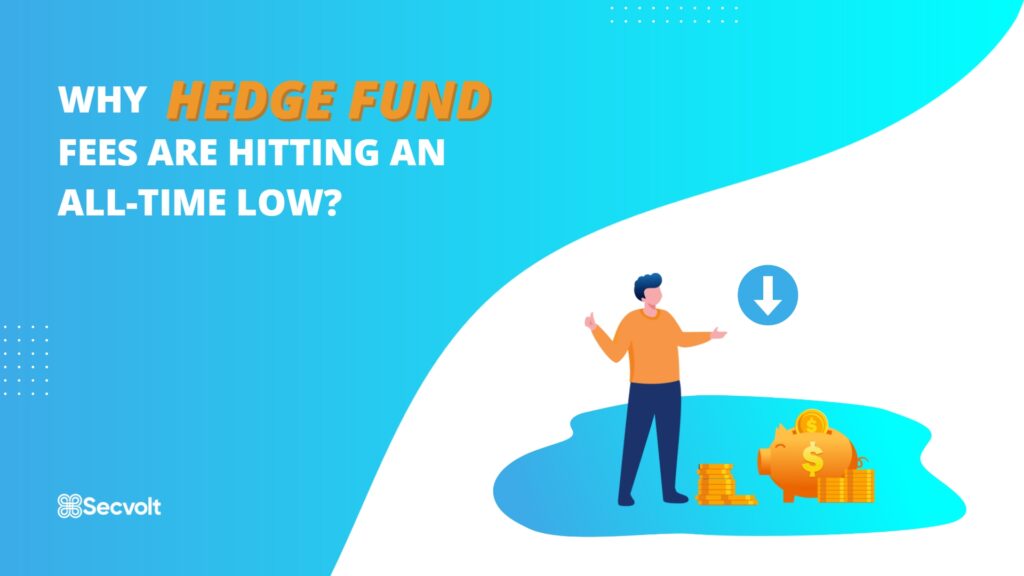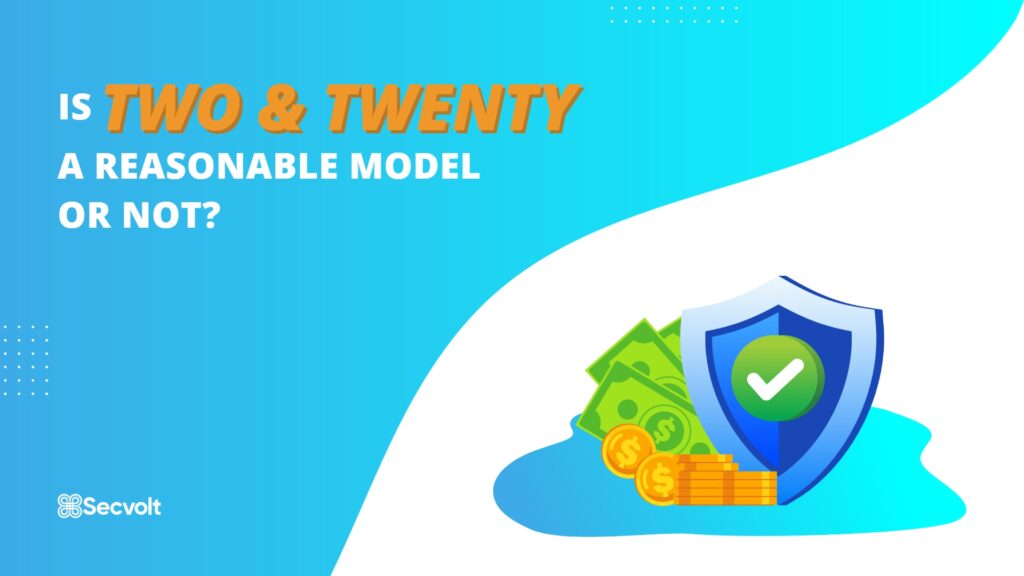
Two & Twenty – Why Are Hedge Fund Fees Hitting An All-Time Low?
Hedge funds are a type of investment vehicle that seek to generate returns for their investors through various strategies, including buying and selling securities, taking long and short positions, and using leverage.
One of the key features of hedge funds is their fee structure, typically known as the “2 and 20” model. This article will delve into the 2 and 20 fee structure, how it works, and why hedge fund fees are hitting an all-time low. We will also explore whether or not the Two & Twenty model is a reasonable way to compensate hedge fund managers.
Let us start by understanding what this model is.

What is the Two & Twenty Hedge Fund Fees Model?
The 2 and 20 Hedge Fund Fees Model is a fee structure used by hedge funds to charge their investors. Under this model, hedge funds charge a management fee of 2% of the total AUM and a performance fee of 20% of the profits earned by the fund. This means that hedge funds charge their investors a fee for managing their investments and an additional fee for generating profits.
The management fee is typically charged to cover the costs of running the hedge fund, like salaries, rent, and other expenses. This fee is generally charged quarterly or monthly and is calculated as a percentage of the total AUM.
On the other hand, the performance fee, as the name suggests, is charged on the performance of a hedge fund. By performance, we mean the profits the hedge fund generates for its investors. The performance fee is calculated as a percentage of the profits made. The standard is 20%.
Together, these 2% & 20% make this hedge funds 2 and 20 fee model. Now, let us understand how this model works.

How Does Two & Twenty Fees Model Work?
The 2 and 20 Fee Structure works as follows:
- Management Fee: The management fee is a percentage of the total AUM. For example, if a hedge fund has $100 million in AUM and charges a management fee of 2%, it will charge its investors $2 million in management fees. As mentioned above, this fee is typically charged on a quarterly or monthly basis.
- Performance Fee: The performance fee is only charged when the hedge fund generates profits for its investors. For example, if the hedge fund generates a profit of $10 million, it will charge its investors a performance fee of 20%, or $2 million.
It is important to note that the 2 and 20 fee structure is applied after the hedge fund’s expenses are deducted from its profits. This means that the hedge fund manager will only receive the performance fee if the hedge fund generates a profit after all expenses have been paid.
Thus, this is how the model works. The 2 & 20 fee model has long been a standard in the hedge fund industry. But in recent years, it has been observed that hedge fund fees are questioned & the prices/fees are regularly decreasing. In the next section, let us look at why this is happening.
If you need some ideas about what to read next, here they are:
- How You Can Invest In The Crypto With Minimum Risk?
- Winter Begins With Everything Steamy In The Crypto World
- Recession Or The Next Great Depression? How To Survive And Thrive Afterward

Why Hedge Fund Fees Are Hitting An All-Time Low?
Despite being the standard hedge fund fee structure, the 2 and 20 model remains questioned. Following are some reasons why hedge fund fees might be declining:
- Competition Among Hedge Funds: As the number of hedge funds has grown significantly over the past few decades, there is increasing competition among managers to attract and retain investors. Some hedge fund managers have had to lower their fees to remain competitive and differentiate themselves from other funds.
- Passive Investment Strategies: The increasing popularity of passive investment strategies, such as index funds, has led to a shift away from actively managed funds. Passive strategies have lower fees than actively managed funds, and investors are becoming more aware of the potential cost savings of these strategies.
- Mediocre Performance: The performance of some hedge funds has not always lived up to the expectations of investors, leading some to question the value of paying high fees for mediocre returns. In response, some hedge fund managers have lowered their prices to demonstrate their commitment to performance and alignment with the interests of their investors.
- Increased Regulation: The hedge fund industry has faced increased regulation in recent years, which has led to higher compliance costs for hedge fund managers. In order to offset these costs, some managers have had to lower their fees in order to remain profitable.
- Alternative Fee Structures: Some hedge fund managers have started to adopt alternative fee structures to the 2/20 fee structure, such as the “one and fifteen” model or the “one and ten” model, in order to differentiate themselves from other funds and offer more attractive fee structures to investors.
- Pressure From Investors: Investors have become savvier and are demanding lower fees from hedge fund managers. Some investors have even negotiated lower fees directly with the managers of their hedge funds to reduce their costs and increase their potential returns.
- Increased Scrutiny Of The Industry: In 2010 came the Dodd-Frank Wall Street Reform and Consumer Protection Act. Under this, hedge funds need to register with the Securities and Exchange Commission (SEC) and disclose more information about their fee structure & operations.
Despite the decline in hedge fund fees, the industry’s 2 and 20 fee structure remains the norm. While some hedge funds have started experimenting with alternative fee structures, such as charging a flat fee or a percentage of profits only, the 2 & 20 model remains the most widely used.
Now, we’ve seen the reason for its decline. It’s time to evaluate whether it is a reasonable fee structure. Let us explore this part in the next section.

Is Two & Twenty A Reasonable Model Or Not?
Critics of the model argue that it aligns the fund manager’s interests with the fund’s performance rather than the investors’ interests. They say that the model allows managers to keep a significant portion of the profits generated by the fund, regardless of whether the returns are due to skill or luck. They also point out that the average hedge fund AUM, or assets under management, is significantly higher than the average AUM of traditional investment funds, leading to higher management fees for hedge fund investors.
“The hedge fund fee structure is broken. It is all about the structure & the net return for us as a long-term institutional investor. And suppose I can get the beta of each of those underlying asset classes at a very low cost. In that case, that’s my core foundation”, says Christopher Ailman, Chief Investment Officer of CalSTRS, the second-largest U.S. public pension fund.
On the other hand, supporters of the model argue that it is necessary to compensate the fund manager for the risk and expertise required to manage a hedge fund and that the 2 & 20 model is reasonable given the value that hedge fund managers add to the fund. They also point out that the management fee, which covers the hedge fund’s operating expenses, is usually lower than the management fees charged by traditional investment funds.
Experts in the industry have also weighed in on the debate over the hedge funds 2 and 20 model. Some experts argue that the model is reasonable given the high level of risk and expertise required to manage a hedge fund and that the performance fee is necessary to incentivize the manager to generate returns for the investors. Others argue that the model is outdated and that hedge fund managers should be compensated based on their ability to add value to the fund rather than simply generating returns.
In the words of Bryan Corbett, President & CEO of Managed Funds Association, “Hedge Funds aren’t for everyone. But clearly, a significant portion of allocators see it as an important part of the mix.”
Hearing both sides makes it difficult to decide which one weighs heavier. Overall, the debate on the 2 & 20 fee structure highlights the need for investors to carefully consider the fee structure of a hedge fund before committing their money. Investors need to understand not only the management fee and performance fee but also any additional fees, such as trading commissions or redemption fees, that may affect the fund’s overall performance. By understanding how hedge funds charge fees, investors can make better decisions regarding investments and the potential returns they may earn.
While this debate may continue on one end of the industry, there is a hedge fund on the other end, which is delivering extraordinary results and not charging any management fee. That makes it a no-management fee hedge fund. Let us have a look at it in our final section.
The Bottom Line
We have discussed the two & twenty hedge fund fee model- its significance, structure, how it works, and the reasons for its decline. We have also examined both sides of the debate about whether this is a reasonable model.
While the debate might continue & more points keep on adding from both ends, you need to check out the highly successful hedge fund Secvolt, which charges zero management fees. Secvolt (www.secvolt.com) has generated year-to-date results as exceptional as 228.71% in 2022. This means it is delivering high returns as well as charging only performance fees. Thus, you have an alternative away from this whole 2 and 20 debate. Secvolt is certainly a win-win situation for you!





